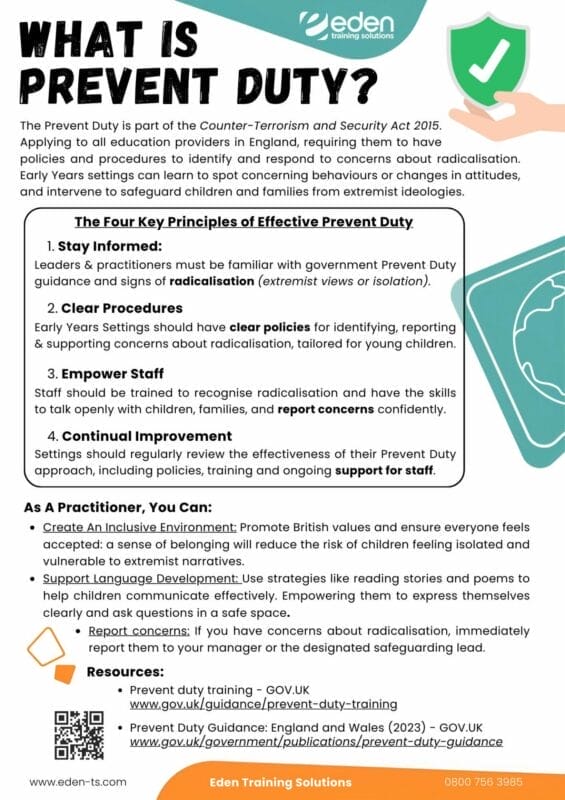What is Prevent Duty and Why is it Crucial?
In contemporary Britain, our society thrives on its multiculturalism, boasting over 300 languages spoken in schools today. This diversity marks a significant aspect of Britain’s 20th-century history, celebrated as a testament to our inclusivity and progress.
However, amidst this rich tapestry, there exist threats to our collective safety, particularly targeting young people under 18, expressed in opposition to multiculturalism, against a multireligious, multiethnic society.

These extremist voices, in their various forms, stand in contrast to the values that modern Britain upholds. Hence, the introduction of Prevent, aimed at safeguarding individuals and offering support to those affected by extremism.
The Prevent Duty in early years is a legal requirement placed on all education providers in England to prevent people from being drawn into terrorism. The aim of the duty is to safeguard vulnerable individuals from the risks of radicalisation and extremist views.
Early years practitioners have an essential role to play in identifying and responding to any concerns about radicalisation and extremism.
They need to have due regard for the need to prevent people from being drawn into terrorism, and to take appropriate measures to safeguard children and young people from these risks.
The Prevent Duty requires early years practitioners to be aware to any signs of extremist behaviour, including expressions of extremist views and promoting extremist ideologies. Whether this is from parents, colleagues, children and visitors to the setting.
Nursery Practitioners must also be aware of the risks associated with radicalisation, such as social exclusion, identity crisis, or a hunger for adventure and excitement.
To fulfil safeguarding responsibilities, early years practitioners need to be able to identify and assess the risks of radicalisation and know how to respond to any concerns appropriately.
This comprehensive guide to the Prevent Duty in the context of early years settings outlines the key steps that early years practitioners can take to fulfil their safeguarding responsibilities. Providing practical guidance on
- how to identify and assess the risks of radicalisation,
- how to develop and implement effective safeguarding polices and procedures,
- and how to work effectively with parents and other professionals to safeguard children and young people.
What is the Prevent Duty?
The Prevent duty aims to safeguard individuals from the risk of radicalisation and extremist views. It applies to all education providers in England, including nurseries, schools, colleges, universities, and early years settings.
The Prevent Duty requires education providers to have polices and procedures in place to identify and respond to any concerns about radicalisation.
The duty aims to promote British values and prevent extremism from taking root in society. Education providers must ensure that their staff are trained to identify the signs of extremist behaviour, such as expressions of extremist views and promoting extremist ideologies.
They must also be able to identify risk factors associated with radicalisation, such as social exclusion or identity crisis.
Early years settings, in particular, have a crucial role to play in safeguarding children and young people from the risks of radicalisation.
They must have due regard for the need to prevent people from being drawn into terrorism and take appropriate measures to safeguard children and young people from these risks.
How does the Prevent Duty relate to safeguarding in early years settings?
The Prevent Duty is closely linked to safeguarding in early years settings. Early years practitioners have a crucial role to play in identifying and responding to any concerns about radicalisation and extremism, as they are often the first point of contact for young children and their families.
Despite the need to prevent people from being drawn into terrorism, early years practitioners can take appropriate measures to safeguard children and young people from these threats.
Safeguarding in early years settings involves much more than just protecting children from physical harm or neglect.
It also involves protecting them from the risk of radicalisation and extremist views. Early years practitioners must work together with parents and other professionals to safeguard children and young people.
It is important to be able to communicate effectively with parents and carers, and work collaboratively with external agencies, such as the local authority, police or healthcare services, if necessary.
What are the key principles of effective Prevent Duty implementation in early years settings?
The first key principle is to have a clear understanding of what the Prevent Duty entails and what the implications are for early years settings. Practitioners and leaders in these settings need to be familiar with the relevant guidance and legislation, such as the Counter-Terrorism and Security Act 2015, and they need to be able to apply it appropriately.
The second key principle is to have robust safeguarding policies and procedures in place that reflect the specific risks associated with radicalisation in early years settings.
This includes having clear processes for identifying and responding to any concerns about radicalisation, as well as effective communication and collaboration with parents and external agencies.
The third key principle is to ensure that all staff are trained and supported to fulfil their Prevent Duty responsibilities.
This includes providing regular training on how to identify and respond to any concerns about radicalisation, as well as promoting a culture of openness and transparency that encourages staff to report any concerns they may have.
The fourth key principle is to regularly review and evaluate the effectiveness of the Prevent Duty implementation in early years settings.
This includes monitoring and evaluating the impact of safeguarding policies and procedures, as well as reviewing the training and support provided to staff.
Effective implementation of the Prevent Duty in early years settings requires a clear understanding of the principles and guidance, robust safeguarding policies and procedures, effective training and support for staff, and regular review and evaluation of the effectiveness. By following these principles, early years settings can fulfil their Prevent Duty responsibilities and safeguard children and young people from the risks of radicalisation and extremism.

The role of early years practitioners in implementing the Prevent Duty
They must be able to identify and respond to any concerns about radicalisation, promote British values, and ensure that their safeguarding policies and procedures reflect the specific risks associated with radicalisation in early years settings.
To fulfil their Prevent Duty responsibilities, early years practitioners must be able to communicate effectively with parents and carers, as well as work collaboratively with external agencies such as the local authority, police, or healthcare services.
This includes sharing information, identifying and assessing risks, and taking appropriate action to safeguard children and young people.
The key thing that practitioners can do, is to create an inclusive practice. Incorporating the British values into what they teach, will help all children, staff and parents feel accepted and included. Which is the fundamental aim of the Prevent Duty.
Practitioners can also support language development and exploration of new concepts by using strategies such as poems with actions and repetition or reading stories aloud and sharing books, as outlined by the Department for Education.
This can help to strengthen language skills, widen vocabulary, and promote effective communication with children and their families.
Effective implementation of the Prevent Duty also requires ongoing training and support for staff, including regular reviews and evaluations of policies and procedures to ensure that they remain effective and up-to-date.
This can help to ensure that early years practitioners are equipped with the knowledge and skills they need to fulfil their Prevent Duty responsibilities and safeguard children and young people from the risks of radicalisation and extremism.
Further information and guidance can be found at:
Prevent duty guidance: England and Wales (2023) – GOV.UK (www.gov.uk)
A useful and informative training course can be completed here:
Prevent duty training – GOV.UK (www.gov.uk)






